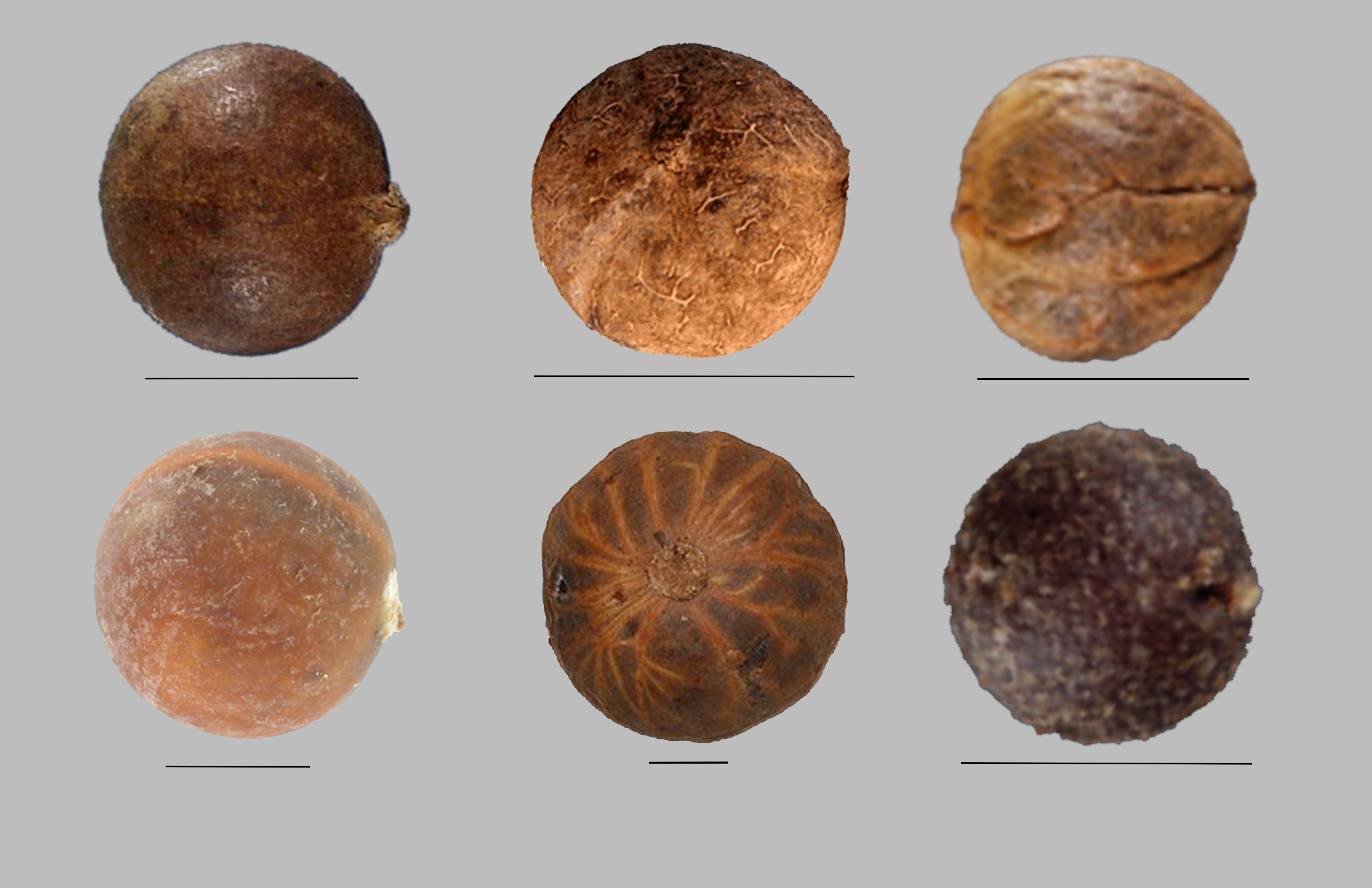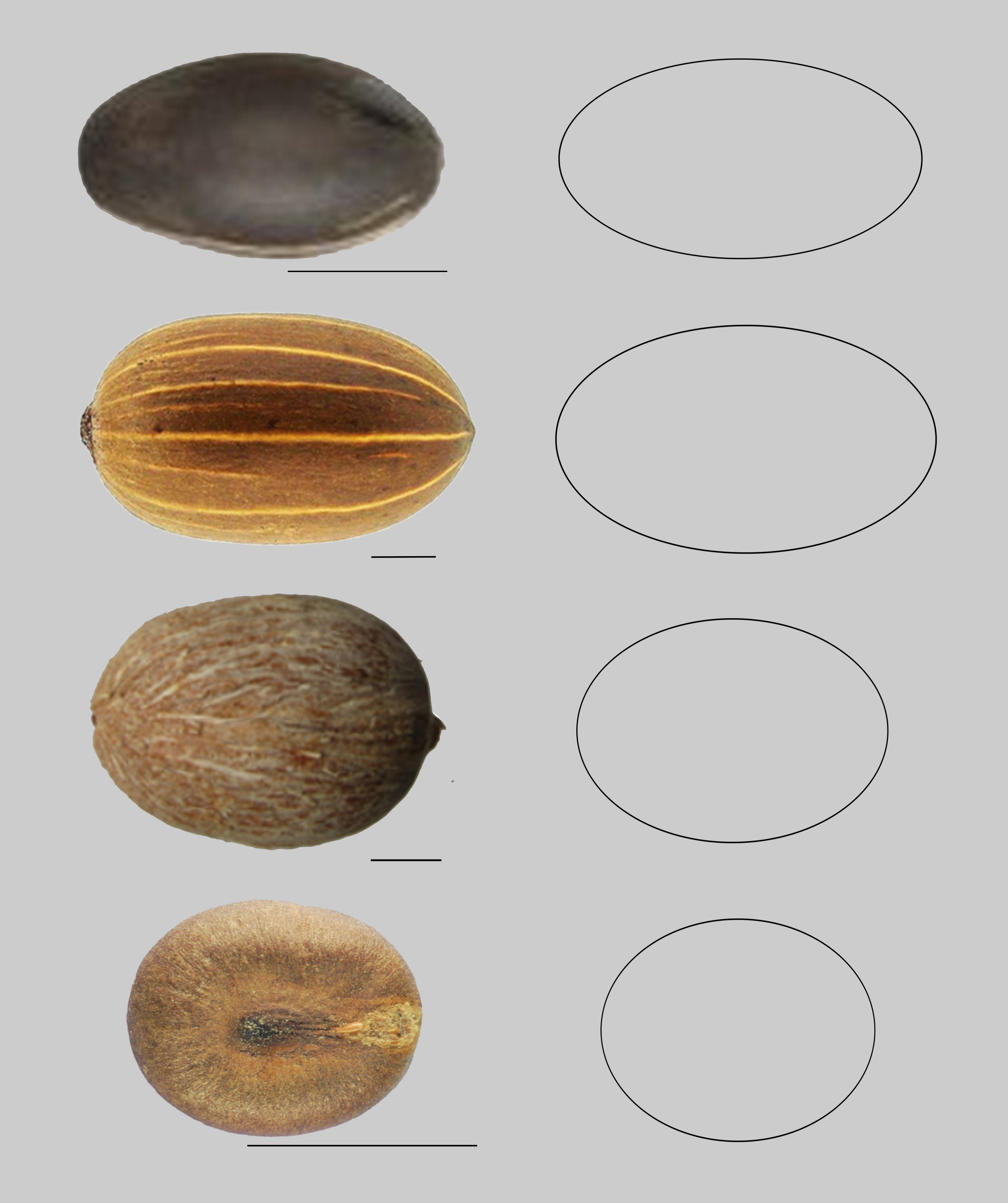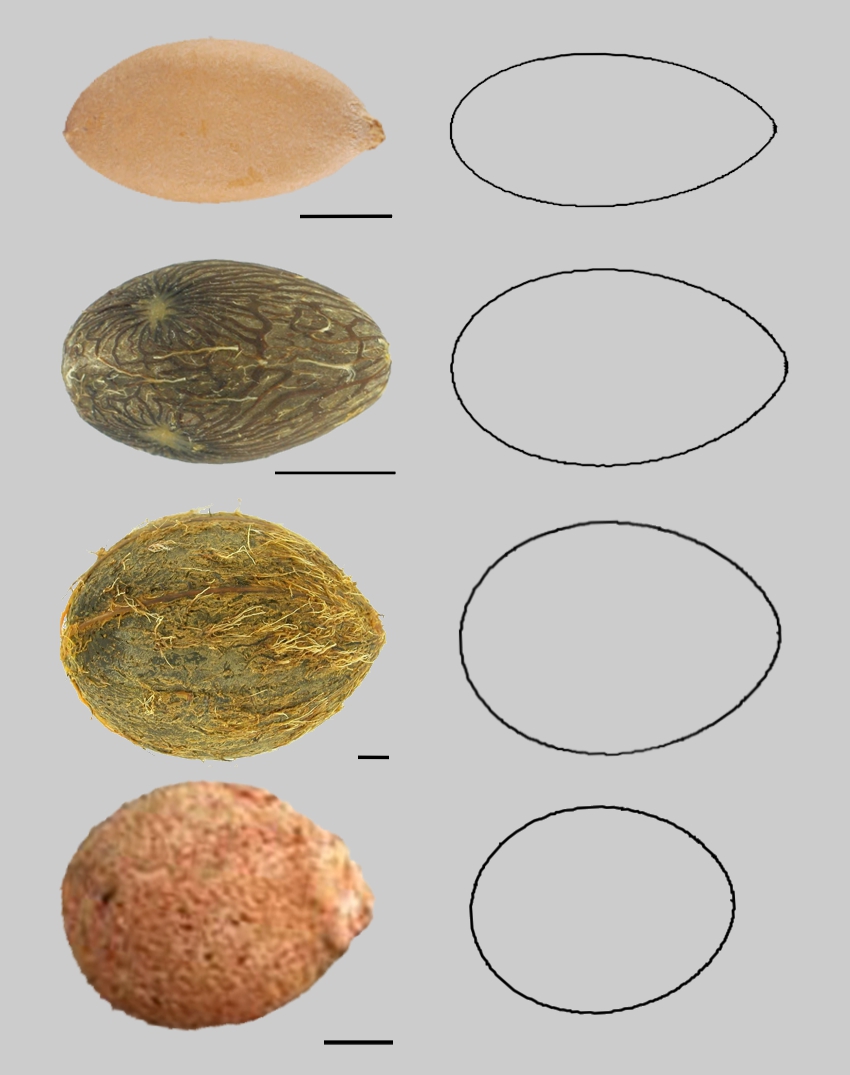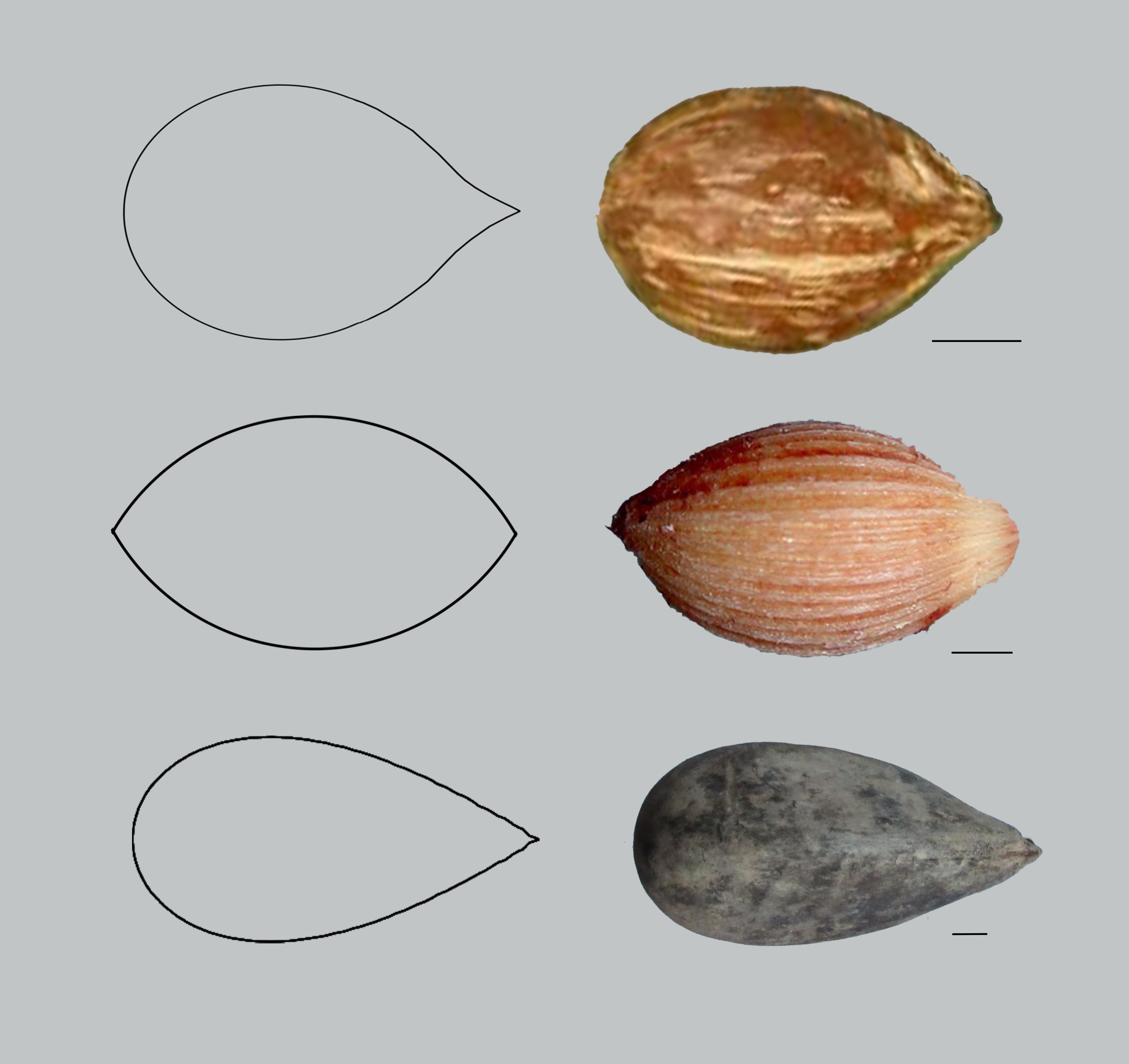
| Version | Summary | Created by | Modification | Content Size | Created at | Operation |
|---|---|---|---|---|---|---|
| 1 | Emilio Cervantes | + 2534 word(s) | 2534 | 2020-10-13 09:59:18 | | | |
| 2 | Peter Tang | -41 word(s) | 2493 | 2020-10-21 06:25:58 | | |
Video Upload Options
Fruit and seed shape are important characteristics in taxonomy providing information on ecological, nutritional, and developmental aspects, but their application requires quantification.
1. Introduction
Fruit and seed shape are important characteristics in taxonomy providing information on ecological, nutritional, and developmental aspects, but their application requires quantification. The shapes of many seeds in the Arecaceae are often described as circular, ellipsoidal or elliptic, globose, ovoid, ovoidal, piriform, or rounded, including double adjectives such as "irregularly globose" or "broadly ovoid" [1].
In this article [2] we have described the shape of seeds in the Arecaceae based on the comparison with a series of geometric models.
Shape is the tridimensional result of complex developmental processes, but the description of it is based on particular aspects. Bi-dimensional images of seeds are often similar to geometric figures that can be used as models. To find a model, the images of different seeds must be taken from a similar perspective to avoid differences in orientation and maximize similarity. The overall shape of the seed (elongated, thinner, or thicker in a different position) and anatomical points (hilium, germination pore, ventral groove) can be references for orientation. Slight changes in orientation can give different images (Figure 1).

Figure 1. Seeds of Phoenix dactilifera L. in three views: dorsal (D), lateral (L), ventral (V). A groove is visible in the ventral side, opposed to the germination pore in a dorsal position. Bar equals 1 cm.
Geometric models can be defined that adjust to the shapes observed making it possible to give accurate morphological descriptions of seed shape for a number of species, as well as the quantification of shape by comparison between the seed image and the model. The possibility of a model depends on the uniformity of seed shape in samples of a given species. Only when the shape is relatively constant, it is possible to describe it by means of a geometric model. Difficulties may arise from developmental aspects.
2. Geometric Models: Definition of the Models
This section describes the geometric figures that are models in the description of seeds in the Arecaceae. Most of the descriptions are accompanied by a formula; these algebraic formulae correspond to the equation in Cartesian coordinates of the curve that delimits the figure (notice that in almost all cases the same name is used for the curve and the figure). The first groups belong to elementary geometry, while the latter groups include a set of figures constructed as graphical representations of algebraic equations. In general, we use the traditional terminology, but a particular case deserves attention. An oval is a convex figure limited by a C2 closed curve. Convex means that any pair of its points are joined by a segment contained in the figure. The C2 property or continuous second degree of smoothness ensures the continuity of the curvature, in particular, the absence of "peaks". In this sense, many common geometric figures are ovals (circles, ellipses…). On the other hand, the word "oval" derives from the similarity with an egg shape (ovus in Latin), and this invites to its utilization in a restrictive sense, that will be used in this work, excluding, e.g., circles and ellipses.
2.1. Circle
The circle [3], the figure delimited by a circumference, is defined, according to Euclid (Book 1 Definition 15):
"A circle is a plane figure bounded by one curved line, and such that all straight lines drawn from a certain point within it to the bounding line, are equal. The bounding line is called its circumference and the point, it's center."
A circumference (centered at the origin) of radius r is represented by the expression:
2.2. Ellipse
The ellipse [4] is "a curve surrounding two focal points, such that for all points on the curve, the sum of the two distances to the focal points is a constant". An ellipse (centered at the origin) is represented by the formula:
where a,b > 0 represent the semi-major and semi-minor axis, respectively. The circumference is a particular ellipse in which the two focal points coincide; in this case, a = b = r.
2.3. Oval
In our restricted sense, an oval is a curve resembling the silhouette of an egg. Unlike ellipses, ovals have only a symmetry axis [5]. Ovals can vary depending on their construction as well as on their degree of symmetry, going from figures close to ellipses to others with a remarked single symmetry. The family of ovals used in this work have the equation
with a > 0; b, c constants.
2.4. Lemniscate
A lemniscate (of Bernoulli) [6] is the locus of points whose product of distances from two fixed points (called foci) equals a constant. A lemniscate is given by the equation
where a is a real constant. By simple algebra, the equation for a half lemniscate is obtained as
2.5. Superellipse
Superellipses [7] can be seen as intermediate curves between an ellipse and its circumscribed rectangle. They are determined by the equation:
with p > 2. In particular, for a = b squared circles are obtained.
2.6. Cardioid and Derivatives
The cardioid [8] has the Cartesian equation:
with a > 0. It has been used as a model for seed morphology in model plants [9][10] and it adjusts well to seeds of many species in diverse taxonomic groups [11][12][13].
2.7. Lens
A lens [14] is a convex region formed as the intersection of two circular disks (when one disk does not completely enclose the other). If the two circles that determine a lens have an equal radius, it is called a symmetric lens, otherwise, it is an asymmetric lens. The Vesica piscis ("fish bladder") is a special type of symmetric lens formed with circles whose centers are offset by a distance equal to the circle radii [15]. The 3D solid obtained rotating a lens around the axis through its tips is called a lemon.
2.8. Waterdrop
In the description of seed shape, it may be useful to modify geometric figures to obtain better adaptations to the bidimensional shape of seeds. For example, we obtained a figure resembling a water drop adapting the basis in the heart curve [16] to a circumference overlapping the maximum width of the curve. It can be seen as the joint graphical representation of the functions:
Derived from this combination (Model 4 in [17]), an elongated waterdrop can be obtained modifying the aspect ratio of the figure.
3. Geometric Models: Examples in the Arecaceae
Table 1. Geometric models with some representative examples of seeds for each morphological type.
|
Geometric Figure |
Representative Examples |
|
Circle (42 examples) |
Acoelorrhaphe wrightii, Acrocomia aculeata, Brahea armata, B. edulis, Butia capitata, Ceroxylon parvum, Chelyocarpus chuco, Coccothrinax argentata, Copernicia alba, C. baileyana, C. macroglossa, Corypha macropoda, C. umbraculifera, Cryosophila stauracantha, Dictyocaryum lamarckianum, Dypsis decipiens, Geonoma congesta, Guihaia argyrata, Hemithrinax ekmaniana, Hydriastele microcarpa, Iriartea deltoideia, Johannesteijsmannia altifrons, Licuala grandis, L. parviflora, L. orbicularis, Livistona chinensis, Livistona jenkinsiana, Metroxylon warburgii, Normanbya normanbyi, Oncosperma horridum, Orania palindan, Pelagodoxa henriana, Prestoea acuminata, P. pubens, Pritchardia pacifica, Rhapis multifida, Sabal mexicana, S. minor, S. uresana, Thrinax excelsa, T.radiata, Wedlandiella sp. |
|
Ellipse (15 examples) |
Adonidia merrillii, Attalea butyracea, Bactris cruegeriana, B. gassipaes, Bismarckia nobilis, Calyptrogyne ghiesbreghtiana, Iriartella sp., Mauritiella aculeata, Nephrosperma vanhoutteanum, Nanorhops ritchiana, Roystonea regia, Socratea exorrhiza, S. salazarii, Washingtonia filifera, W. robusta. |
|
Oval (34 examples) |
Actinorhytis calapparia, Archontophoenix alexandrae, Adonidia merrellii, Astrocaryum standleyanum, Attalea blepharophus, A. cohune, A. martiana, A. speciosa, Beccariophoenix fenestralis, Brahea armata, Brahea moorei, Calyptronoma occidentalis, Carpoxylon macrospermum, Chamaerops humilis, Corypha utan, Cyrtostachys renda, Desmoncus sp., Dypsis bejofo, D. marojejyi, Iriartella sp., Kerriodoxa elegans, Medemia argun, Nannorrhops ritchiana, Oenocarpus sp., Pholidostachys dactiloides, P. occidentalis, P. pulchra, P. synanthera, Retispatha dumetosa, Rhapidophyllum histrix, Serenoa repens, Voanioala gherardii, Wallichia disticha, Washingtonia robusta. |
|
Superellipse (5 examples) |
Cyphophoenix elegans, P. canariensis, Ph. roebelenii, Raphia taedigera, Welfia regia. |
|
Squared circle (4 examples) |
Johannesteijsmannia altifrons, Clinosperma macrocarpa, Mauritia flexuosa, Ravenea rivularis |
|
Half lemniscate (10 examples) |
Aphandra natalia, Astrocaryum alatum, A. urostachys, Attalea dubia, Beccariophoenix fenestralis, Brahea moorei, Latania loddigesii, Pholidostachys panamensis, Phytelephas macrocarpa, Veitchia sp. |
|
Lens (3 examples) |
Asterogyne martiana, Butia sp., Carpentaria acuminata |
|
Water drop (1 example) |
Syagrus romanzoffiana |
3.1. Seeds that Project Circular Images
Round seeds project circular images from any perspective. However, ellipsoidal and ovoidal seeds can also give circular images that are useful for species identification and classification. For an accurate description, the seed orientation has to be given and, in any case, values of J index need to be obtained in a representative number of samples. Figure 2 shows representative examples of circular seeds: Acoelorrhaphe wrightii (Corypheae, Coryphoideae), Acrocomia aculeata (Cocoseae, Arecoideae), Coccothrinax argentata (Cryosophileae, Coryphoideae), Geonoma congesta (Geonomateae, Arecoideae), Iriartea deltoideia (Iriarteeae, Arecoideae), and Thrinax radiata (Cryosophileae, Coryphoideae). Other examples are also found in diverse sub-families and tribes.
Figure 2. Representative examples of round seeds (J index values are indicated between parentheses). From left to right: Acoelorrhaphe wrightii (93.6), Acrocomia aculeata (95.7), Coccothrinax argentata (92.6), Geonoma congesta (96.1), Iriartea deltoideia (95.3), and Thrinax radiata (95.4). The seed of Iriartea deltoidea is oriented with the attachment of the peduncle in a frontal position. In the other seeds, the place of attachment of the peduncle is in a lateral position. Bars represent 0.5 cm.
3.2. Elliptical Seeds
Ellipsoidal seeds give bi-dimensional images that vary from circular to elliptical, depending on the selected point of view. The elliptical shape is determined by the ratio between the major and minor axes (aspect ratio). Figure 3 shows representative examples of seeds whose images adjust well to ellipses of different values. These are Iriartella sp. and Socratea exorrhiza (Iriarteae, Arecoideae), Adonidia merrillii (Areceae, Arecoideae), and Washingtonia filifera (Corypheae, Coryphoideae). Other examples are also found in diverse sub-families and tribes.
Figure 3. Representative examples of elliptic seeds with their respective models (J index values are indicated between parentheses): Iriartella sp. (94.4), Socratea exorrhiza (91.6), Adonidia merrillii (92.0), and Washingtonia filifera (91.9). The seed of W. filifera (bottom) is oriented with the attachment of the peduncle in a frontal position while in the other three seeds the attachment of the peduncle is in a lateral position. Aspect ratio values for the ellipses are (from top to bottom): 1.8, 1.7, 1.4, and 1.2. Bars represent 0.5 cm.
3.3. Seeds Resembling Ovals
As was pointed out in Section 4.3, the oval has just one symmetry axis. A list of species whose seed images resemble ovals are given in Table 3. A useful mode to define the oval is by an algebraic formula, see, e.g., Equation (3). Figure 4 contains representative examples of oval seeds with their respective models: Serenoa repens (Corypheae, Coryphoideae), Desmoncus sp. (Cocoseae, Arecoideae), Astrocaryum standleyanum (Cocoseae, Arecoideae), and Medemia argun (Borasseae, Coryphoideae). Other examples are also found in diverse sub-families and tribes.
Figure 4. Representative examples of seeds, whose images adjust well to different ovals, (J index values are indicated between parentheses). From top to bottom (more to less elongated): Serenoa repens (90.0), Desmoncus sp. (93.6), Astrocaryum standleyanum (91.5), and Medemia argun (92.1). The ovals correspond to the equations given in the text. Bars represent 0.5 cm.
The shape of the seeds represented in Figure 4 are ovals and all the curves representing them have been obtained with Equation (3) varying the parameters:
-
Serenoa repens ;
-
Desmoncus sp.;
-
Astrocaryum standleyanum;
-
Medemia argun
Once a model has been proposed for a species or a population, the proposal has to be validated statistically. T-test allow us to validate the hypothesis that seed lots belong to a given morphological type. We consider that a seed population belongs to a given morphological type when the hypothesis test concludes that the mean J index of the species is equal to or superior to 90 with a significance level of 95%. An example is later given with seeds of Phoenix canariensis (Figure 5).
Figure 5. An example of the superellipse (model) and representative seeds adjusting to models in this family (between parentheses the values of J index with this model): P. canariensis (92.15 is the mean value of 25 seeds), Welfia regia (92.6), and Raphia taedigera (90.0). Bars represent 0.5 cm. The model is defined by Equation (6) with = 3.6, = 2.2, and = 2.4.
The transitions between related forms (Circle–Ellipse–Oval) are very subtle and many species have seeds of variable shape. A mixture of shapes of the main types may be observed in images containing multiple seeds of the following species: Actinorhytis calaparia, Aiphanes horrida, Archontophoenix alexandrae, Bismarckia nobilis, Brahea armata, Caryota maxima, Chamaedorea tuerkeimii, Chamaerops humilis, Corypha utan, Guihaya argyrata, Jubaeopsis caffra, Medemia argun, Nanorrhops ritchiana, and Washingtonia robusta.
3.4. Seeds Resembling the Superellipse and Related Figures
The superellipses and squared circles are figures that, to our knowledge, have not yet been mentioned in the morphological description of seeds in the Arecaceae.
The squared circle may be considered as a particular case of the superellipse (Equation 6). Figure 5 represents the superellipse and seeds representative of this morphological type. The seeds of P. canariensis (Phoeniceae, Coryphoideae), Welfia regia (Geonomateae, Arecoideae), and Raphia taedigera (Lepidocaryeae, Calamoideae) adjust to a superellipse. The hypothesis test done with 25 seeds (sample mean = 92.15) concludes that the mean J index of the population of P. canariensis from which the seeds were taken is equal or superior to 90 with a significance level of 99%.
The seeds of Clinosperma macrocarpa (Areceae, Arecoideae), Johannesteijsmannia altifrons (Chuniophoeniceae, Coryphoideae), and Mauritia flexuosa (Lepidocaryeae, Calamoideae) and others (Table 3) adjust to a squared circle (Figure 6).
Figure 6. The squared circle (model) and representative examples of seeds adjusting to it (between parentheses the values of J index with the respective models): Clinosperma macrocarpa (91.5), Johannesteijsmannia altifrons (92.4), and Mauritia flexuosa (92.0). In C. macrocarpa the seed is orientated with the stem end in a central position, while the other seeds present a side view. The model is defined by Equation (6) with = = 1, and = 3.
3.5. Seeds Resembling Other Figures: Half Lemniscate, Lens and Waterdrops
The figures of half lemniscate and waterdrops resemble elongated ovals with a peak in their apex. Depending on the degree of asymmetry perpendicular to the symmetry axis, the seeds resembling ovals may have shapes near to ellipses, such as Medemia argun or, on the other hand, be more asymmetric and divergent from the ellipse, such as Serenoa repens (see Figure 6). In other seeds there is still more asymmetry between the two poles, giving images similar to half lemniscate as in the case of some seeds of Aphandra natalia (Phytelepheae, Coryphoideae, Figure 7). Seeds of this type can be observed in other species such as Astrocaryum urostachis, Syagrus romanzoffiana and Beccariophoenix fenestralis (Cocoseae, Arecoideae), Phytelephas macrocarpa (Phytelepheae, Coryphoideae), Pholidostachys panamensis (Geonomeae, Arecoideae), and Wodyetia bifurcata (Areceae, Arecoideae).
Images of seeds of Asterogyne martiana (Geonomeae, Arecoideae) adjust well to a lens. This model may also be helpful in the quantification of some seeds in Butia sp. (Cocoseae, Arecoideae), Carpentaria acuminata (Areceae, Arecoideae), and others.
Figure 7. Water Drop, Lens, and Half Lemniscate with examples of seeds resembling each of the models (between parenthesis values of J index with the respective model): Syagrus romanzoffiana (92.3, mean of three seeds), Asterogyne martiana (91.8), and Aphandra natalia (93.8). Bars represent 0.5 cm.
4. Conclusion
Seed morphometry provides interesting tools for the identification of species in regions with a great diversity of palms, such as the Amazon basin. The seeds are critical structures in taxonomy in many cases where vegetative organs are similar among different species. In addition, thanks to their very resistant endocarp, seeds are easy to find and last a long time under the tree producer allowing differentiation up to the level of species in many instances.
The development of software of image identification based on geometric models may be an interesting contribution to future biodiversity studies.
References
- Dransfield, J.; Uhl, N.W.; Asmussen, C.B.; Baker, W.J.; Harley, M.M.; Lewis, C.E. Genera Palmarum: The Evolution and Classification of Palms; Kew Publishing, Royal Botanic Gardens of Kew.: London, 2008; pp. 732.
- Diego Gutiérrez Del Pozo; José Javier Martín-Gómez; Ángel Tocino; Emilio Cervantes; Seed Geometry in the Arecaceae. Horticulturae 2020, 6, 64, 10.3390/horticulturae6040064.
- Circle . MathWorld—A Wolfram Web Resource. Retrieved 2020-10-20
- Ellipse . MathWorld—Wolfram Web Resource . Retrieved 2020-10-20
- Oval . MathWorld—A Wolfram Web Resource. . Retrieved 2020-10-20
- Lemniscate . MathWorld—A Wolfram Web Resource. Retrieved 2020-10-20
- Superellipse . MathWorld—A Wolfram Web Resource. Retrieved 2020-10-20
- Cardioid . MathWorld—A Wolfram Web Resource. Retrieved 2020-10-20
- Emilio Cervantes; José Javier Martín; Ramón Ardanuy; Juana G De Diego; Ángel Tocino; Modeling the Arabidopsis seed shape by a cardioid: Efficacy of the adjustment with a scale change with factor equal to the Golden Ratio and analysis of seed shape in ethylene mutants. Journal of Plant Physiology 2010, 167, 408-410, 10.1016/j.jplph.2009.09.013.
- Emilio Cervantes; José Javier Martín; Pick Kuen Chan; Peter M. Gresshoff; Ángel Tocino; Seed shape in model legumes: Approximation by a cardioid reveals differences in ethylene insensitive mutants of Lotus japonicus and Medicago truncatula. Journal of Plant Physiology 2012, 169, 1359-1365, 10.1016/j.jplph.2012.05.019.
- José Javier Martín Gómez; Diego Gutiérrez Del Pozo; Emilio Cervantes; Seed Shape Quantification in the Malvaceae Reveals Cardioid-Shaped Seeds Predominantly in Herbs. Botanica 2019, 25, 21-31, 10.2478/botlit-2019-0003.
- Josè Javier Martín-Gómez; Agnieszka Rewicz; Emilio Cervantes; Seed Shape Diversity in families of the Order Ranunculales. Phytotaxa 2019, 425, 193-207, 10.11646/phytotaxa.425.4.1.
- Saadaoui, E.; Martín-Gómez, J.J.; Cervantes, E; . Seed morphology in Tunisian wild populations of Capparis spinosa L. . Acta Biol. Cracov. Bot. 2013, 55, 99–106.
- Lens . MathWorld—A Wolfram Web Resource. Retrieved 2020-10-20
- Vesica Piscis . MathWorld—A Wolfram Web Resource. Retrieved 2020-10-20
- Heart Curve . MathWorld—A Wolfram Web Resource. Retrieved 2020-10-20
- José Javier Martín Gómez; Diego Gutiérrez Del Pozo; Mariano Ucchesu; Gianluigi Bacchetta; Félix Cabello Sáenz De Santamaría; Ángel Tocino; Emilio Cervantes; Seed Morphology in the Vitaceae Based on Geometric Models. Agronomy 2020, 10, 739, 10.3390/agronomy10050739.


















